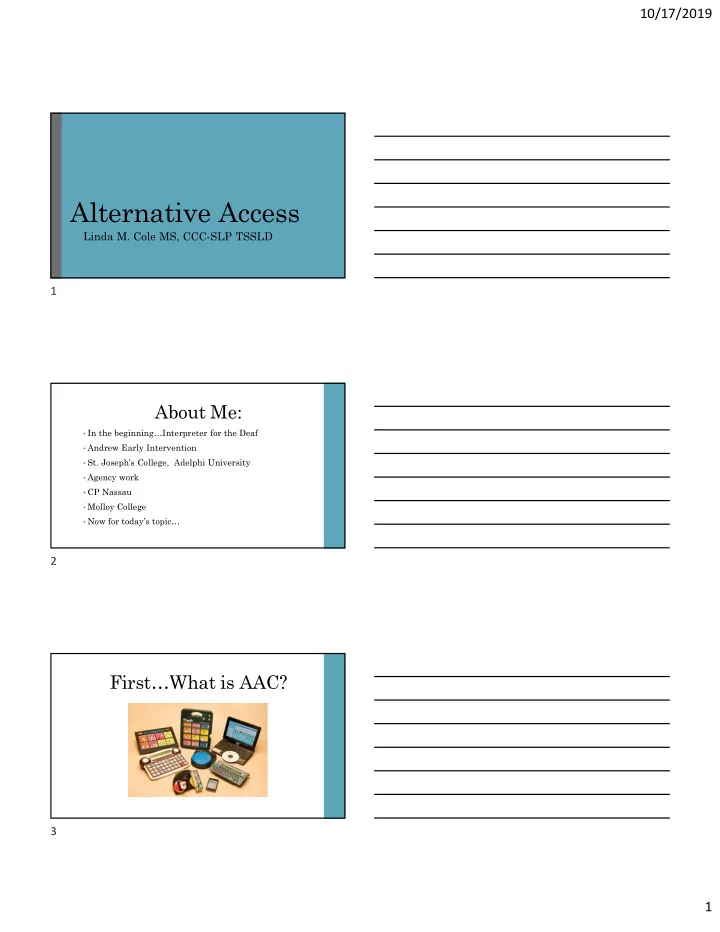

10/17/2019 Alternative Access Linda M. Cole MS, CCC-SLP TSSLD 1 About Me: • In the beginning…Interpreter for the Deaf • Andrew Early Intervention • St. Joseph’s College, Adelphi University • Agency work • CP Nassau • Molloy College • Now for today’s topic… 2 First…What is AAC? 3 1
10/17/2019 Second…What is Alternative Access? • Many individuals with Complex Communication Needs (CCN) also present with physical impairments • Movement challenges can make direct selection extremely difficult or impossible • Devices and technologies used to support access needs of individuals with severe physical impairments 4 4 Areas of Learning in AAC Operational Linguistic Social Strategic 5 Why is access so important? There are many barriers that our AAC users must overcome to be competent communicators…an inappropriate access recommendation should not be one of them… 6 2
10/17/2019 Selection Set • Selection set of an AAC system includes the visual, auditory, or tactile presentation of all messages, symbols, and codes that are available at one time to a person who uses AAC. • Computer displays • Visual displays • Auditory/Tactile displays 7 Types of Selection Set Displays • Fixed • Dynamic • Hybrid • Visual Scene 8 Physical Consideration of Displays • Number of items • Size of items • Spacing of items • Orientation of Display 9 3
10/17/2019 For Example: • Direct selection is possible with 8 symbols per page, no smaller than 2” in size • 24 months vocabulary can be ~300 words • Weigh the complexity of navigation • Think about as language develops 10 Selection Techniques Direct Selection Scanning Physical contact Circular Physical Pressure Linear No contact pointing Group-item 11 Physical Considerations of individuals with CCN: Positioning/Seating • Individuals who have increased/decreased muscle tone • Efficient use of AAC will require external support or environmental adaptations to compensate • Consider reflexes • Scoliosis – motor experts on the AAC team will need to compensate • Athetosis – uncontrolled movements 12 4
10/17/2019 Principles and Techniques • It is easy to underestimate an individuals capabilities if he/she is not properly seated and supported. • Improper seating and inadequate support can result in fatigue and discomfort. Emotional state, attention as well as ability to move may be compromised. 13 Principles and Techniques • FIRST STEP IN ASSESSMENT IS OPTIMIZING POSITIONING Use yourself as a reference Ensure stable base of support Decrease the influence of atypical muscle tone Accommodate deformities Provide least amount of intervention to achieve greatest level of function Provide support for resting 14 Assess Motor Capabilities • Identify a gestural y/n response for assessment/back-up and identify alternative access for long term • Discover motor capabilities, do not describe motor problems Short Term techniques Can the individual answer y/n questions accurately? If reliably “yes” there is your short term direct selection technique… If not highly accurate and unambiguous then assess hand If not then assess eye gaze ALLOW ADEQUATE TIME – IT FEELS TO LONG TO US – WAIT!!! 15 5
10/17/2019 Long Term Motor Skills • Minimize cognitive, linguistic and technical demands so that motor control can be assessed in isolation • Direct selection Hand/arm Head/orofacial control Foot/leg • Provided temporary manual supports • Optimize control Accuracy Maximum range and number of targets Adaptations • Assess negative impact 16 Switch Assessment for Scanning • Again minimize the cognitive, visual and communication demands consider using a switch activated toy, or a simple computer game. • Hands, head, feet, legs and knees 17 Switch Assessment for Scanning • 6 components Wait Activation Hold Release Waiting Reactivating 18 6
10/17/2019 Scanning • Directed Scanning – cursor moves as long as switch is activated • Automatic Scanning – activate switch to start scan pattern, hit switch again to select • Step Scanning – one to one correspondence 19 Types of Switches • Buttons • Wobble • Wireless Bluetooth/Radio Frequency • Sip/Puff • Proximity • String • Grasp • Twitch 20 Feedback • Activation - Let’s the individual know an item has been selected • Message – Provides the individual with information about the message that has been formulated 21 7
10/17/2019 Any questions?? 22 Eye Gaze • No contact direct selection method • Technology that uses a camera and an IR light source to illuminate the eyes and then the reflections on the cornea are used as a reference for eye gaze and eye movements 23 Consider: Eye Disorders • Cataracts • Ptosis • Nystagmus • Strabismus • CVI • Mydriasis 24 8
10/17/2019 Story to Share… • It all started with the question: • Do you know how to calibrate an eye gaze? 25 Head-Tracking • No contact direct selection method • Camera mounted on device which also uses IR technology to detect a reflective dot worn by the user • Translates the users movements into cursor movements 26 Any questions?? Thank you for your time and attention!! 27 9
10/17/2019 References Beukelman, D.R., & Mirenda, P. (2013). Augmentative and alternative communication: Supporting Children & adults with complex communication needs. Baltimore, MD: Brooks. Kay, D. (2014). Holistic Approach to Physical Motor Access Assessment in Pediatric AAC. Perspectives on Augmentative and Alternative Communication, Vol 23 pages 84-90. Kay Chen, S., O’Leary, M. (2018). Eye Gaze 101: What Speech Language Pathologists Should Know About Selecting Eye Gaze Augmentative and Alternative Communication Systems. Perspectives of the ASHA Special Interest Groups SIG 12, Vol 3 (Part 1) pages 24-32. Koch Fager, S. (2018). Alternative Access for Adults that Rely on Augmentative and Alternative Communication. Perspectives of the ASHA Special Interest Groups SIG 12, Vol 3 (Part 1) pages 6-12. https://pubs.asha.org 28 10
Recommend
More recommend